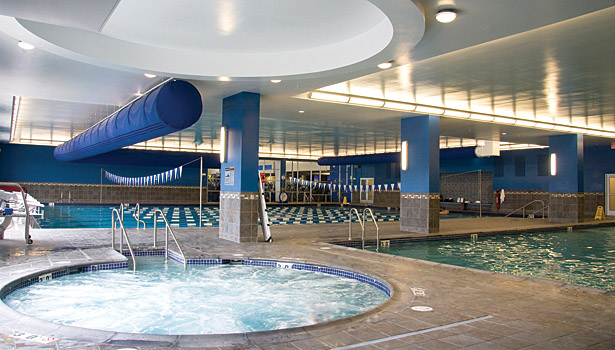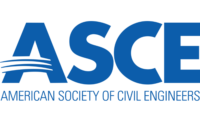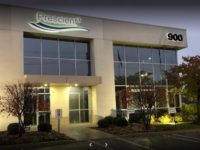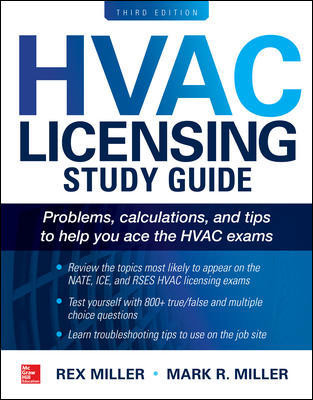The new $24 million Hackensack UMC (HUMC) Fitness and Wellness Center is unique in several ways. First, it is the only center of its kind affiliated with a National Football League franchise (the New York Giants). Also, the HVAC equipment operates at high efficiencies and with 80% less refrigerant, which fit perfectly into the facility’s environmental stewardship goals.
“Every center we build is more sustainable than its predecessor, and the HUMC facility had an even more aggressive green mission,” said Gary Reidy, CEO and founding partner of Fitness & Wellness Professional Services (FWPS).
The project emulates environmental stewardship in other HUMC programs such as the main hospital’s in-house Dierdre Imus Environmental Health Center®, a not-for-profit children’s advocacy group dedicated to controlling and preventing environmental toxic exposure. Thus, project architect and engineering firm, Jarmel-Kizel Architects and Engineers Inc., in Livingston, NJ, purposely specified reduced refrigerant equipment, low VOC materials, and other measures to complement HUMC’s ongoing environmental goals.
Other sustainable efforts can be found in the aquatics center, which features a Protocol, NP-Series dehumidifier that uses 80% less refrigerant. The 70-ton, 23,000-cfm HVAC system dehumidifies, cools, and heats the 8,000-sq-ft aquatic space to a 50% relative humidity and 80°F space temperature. The Protocol substitutes glycol for the estimated 690-pounds of R-410A refrigerant used by a similar-sized conventional dehumidifier.
Similar to other FWPS facilities, the natatorium features a diverse mix of aquatics all in one space, such as 75-ft by 32-foot lap (79-81°F) and 20-ft by 40-foot therapy (90°F) pools, and a 12-ft-diameter spa (104°F). Controlling water temperatures appropriate for the many activities, in addition to maintaining ideal IAQ of space temperature and humidity, is critical for targeting FWPS’ wide demographic of youth to 90+ years old.
To dehumidify and cool, the system does use 140 lbs of R-410A refrigerant in an internal refrigeration circuit requiring no jobsite installation because it’s factory-charged and sealed. For heat rejection, the rooftop unit’s heat exchangers transfer the refrigeration circuit’s heat to glycol for either free supply air reheat or heat rejection to dry coolers. Compared to refrigerants, glycol is 95% less expensive and minimally environmentally-damaging in the event of a leak. External PVC glycol piping to dry coolers significantly reduced project labor and material costs versus copper piping, refrigerant, and air cooled condensers.
The reduced refrigerant strategy increases reliability because refrigerant leak potential is reduced and compressor lifecycles are lengthened by eliminating oil migration issues that are common to heat rejection methods using refrigerant and long copper piping runs to air cooled condensers, according to Ed Sneed, sales engineer at Stillwell-Hansen Inc., who helped bring the reduced refrigerant idea to the design table.
“It’s insane to use hundreds of pounds of refrigerants when today’s new HVAC technology affords us the opportunity scale them back,” said Sneed.
Stephen D. Kay, managing partner responsible for property management and construction, said he has seen HVAC units with reduced refrigerant as a major advantage in reducing operation costs.
“When a leak has occurred in our older centers’ conventional, 100% refrigerant aquatic HVAC equipment, it’s typically a $5,000 minimum service charge due to the significant materials expense of replenishing the lost refrigerant,” he said.
The Protocol’s proprietary heat rejection design makes it equally efficient as DX systems on summer design days, and 5 % to 7% more efficient throughout the rest of the year. The design uses an active refrigeration head pressure monitor/control that ensures the lowest possible condensing pressures to boost system performance. Standard maintenance-free direct drive blowers with VFD also provide additional operational efficiencies.
The dehumidifier also provides free pool water heating from the refrigeration circuit’s heat recovery, and energy recovery from exhaust air to preheat outdoor air.
The mechanical systems also include two boilers by Lochinvar for heating domestic hot water and backing up pool water heating. The dehumidifier provides the majority of pool water heating, however, the pool area’s three vessels each have a boiler for quick water heating during dump/fills, cleanings, and sand filter backwashing.
The center’s other HVAC design includes packaged rooftop systems ranging from 7.5 to 50 tons for employing both constant volume and VAV strategies. Voyager Series rooftops and an Intellipak by Trane supplies the medical offices, cafeteria, children’s center, athletic rooms, and a combination of mixed use spaces.
The Trane system provides building automation control, however, the dehumidifier has an autonomous on-board Command Center with an ethernet connection to Seresco’s proprietary WebSentry system, which gives real time data of more than 60 operating conditions, such as compressor suction pressure, space temperature, fan speeds, and other parameters. WebSentry also sends out email alarms to Stillwell-Hansen, HUMC’s aquatic management division, and factory technicians, who can access operating info from any web browser or smartphone. Sneed has already saved the center a service call by making dehumidifier fan adjustments via his smartphone during the first week’s start-up.
“This system will always operate at its full efficiency capacity because any malfunction can be adjusted via the internet or requisitioned immediately for service, instead of unknowingly operating inefficiently for six months or more until it’s detected during the next semi-annual service check-up,” said Sneed.






